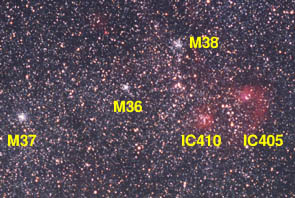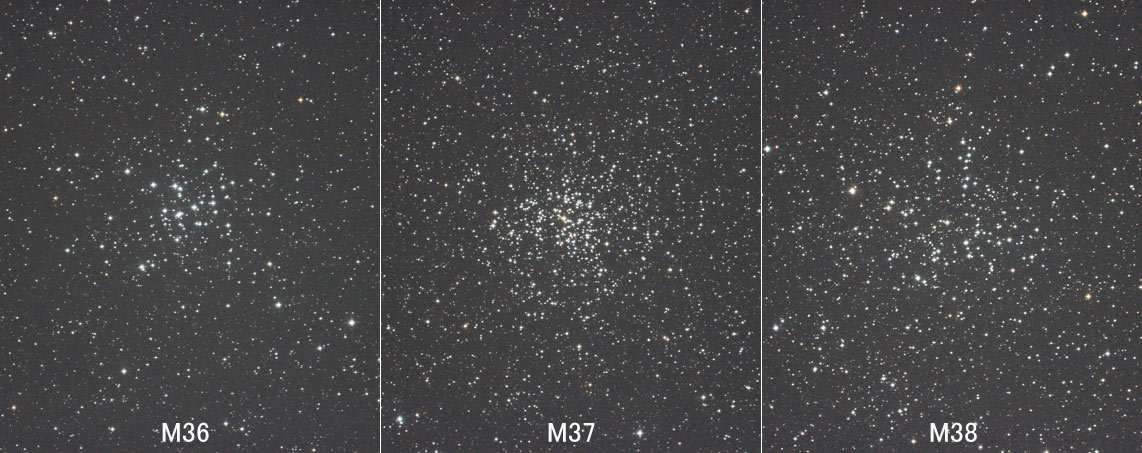Deep Sky Object in Winter
M36, M37, M38 (Open Clusters in Auriga)
| Date & Time: | M36: Dec 14 2014, 21:05 to 21:17 JST(+0900), 2min.×6shots |
| M37: Dec 14 2014, 21:24 to 21:35 JST(+0900), 2min.×6shots |
| M38: Dec 14 2014, 21:40 to 21:50 JST(+0900), 2min.×6shots |
| Optical: | VIXEN 20cm(7.9") VISAC with a conversion lens (f=1278mm, F6.4) |
| with BaaderPlanetarium Moon&Skyglow filter |
| Auto-guided with TAKAHASHI EM-200 Equatorial |
| Digital Camera: | Canon EOS 600D (Remodeled) |
| Location: | Hiraiso, Hitachi-naka city, Ibaraki pref. |
| Camera Settings: | Recording format...14bit CCD-RAW, converted to 16bit TIFF(5184×3456) |
| Sensitivity...ISO3200 |
At about the zenith in winter sky, a trio of open clusters is bathed in the faint Milky Way of Auriga.
They are paralleled M37 (NGC2099), M36 (NGC1960), and M38 (NGC1912) from east to west. M38 has a bit sparser star-density than other two,
only M38 is classified in type f, M36 and M37 have a type of e.
Both appearances and real scales of all three are very alike. A telescope is preferred but you can at least locate these objects with binoculars.
It'll be very interesting to compare their distributions of stars and/or detailed structures with telescopes.
They have sizes of about 20 arc minutes and distances of 3500 to 4700 light years approximately.
|

Wide-field image around M36,M37,M38 |
| M36 (NGC1960) / Open Cluster, type f, I 3 r |
|---|
| R.A. | 05h 36m 6.0s (2000.0) |
|---|
| Dec. | +34° 08' 00" (2000.0) |
|---|
| Apparent Size | 12' |
|---|
| Real Size | 13 light yrs. |
|---|
| # of Stars | 60 |
|---|
| Magnitude | 6.3 |
|---|
| Distance | 3780 light yrs. |
|---|
|
| M37 (NGC2099) / Open Cluster, type f, I 2 r |
|---|
| R.A. | 05h 52m 24.0s (2000.0) |
|---|
| Dec. | +32° 32' 59" (2000.0) |
|---|
| Apparent Size | 20' |
|---|
| Real Size | 27 light yrs. |
|---|
| # of Stars | 150 |
|---|
| Magnitude | 6.2 |
|---|
| Distance | 4720 light yrs. |
|---|
|
| M38 (NGC1912) / Open Cluster, type e, type II 2 r |
|---|
| R.A. | 05h 28m 42.0s (2000.0) |
|---|
| Dec. | +35° 50' 00" (2000.0) |
|---|
| Apparent Size | 20' |
|---|
| Real Size | 21 light yrs. |
|---|
| # of Stars | 100 |
|---|
| Magnitude | 7.4 |
|---|
| Distance | 3580 light yrs. |
|---|
|


